Silver Power Blue Lightning 600W
by Christoph Katzer on August 27, 2007 6:00 AM EST- Posted in
- Cases/Cooling/PSUs
Test Setup
As usual we are testing with our Chroma programmable loads to fully load each rail to a specific amount. This is important to get truly accurate results and not merely approximate values. The tests are conducted in two different temperature environments. One is normal room temperature of 25-26°C, while the second environment goes from room temperature and increases steadily up to 50°C. Especially during the higher temperatures we will see how good the power supplies are and what they're really made of. Components inside will perform much worse at higher temperatures, but we expect any good quality PSU to deal with such test conditions without failing.
Note: If you would like to know more about our testing methodology, equipment, and environment, please read our PSU testing overview.
3.3V DC Output
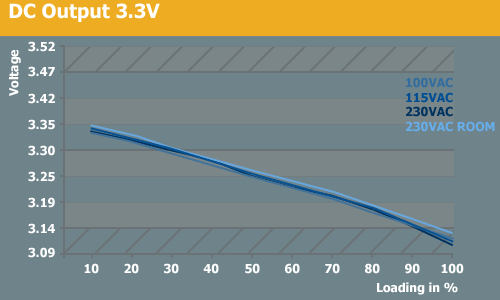
The 3.3V rails were stable during testing, as usual showing a constant drop under increasing load. At maximum loads, the 3.3V rail does go out of spec, regardless of temperature. However, the consistency of the rail outputs regardless of temperature and input voltage is surprising, with all four test results paralleling each other.
5.0V DC Output
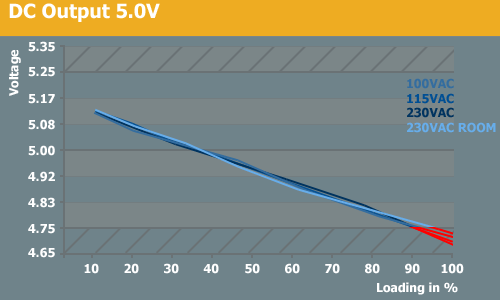
Results with the 5V rail are similar to the 3.3V rail. All four test cases parallel each other, dropping steadily under increasing load. At about 90% load, the 5V rail falls out of spec. It is unlikely that most users will put anywhere near a 90% load on a 600W power supply, and provided you stay below 80% load on the 3.3V and 5V rails there shouldn't be any problems.
5Vsb Output
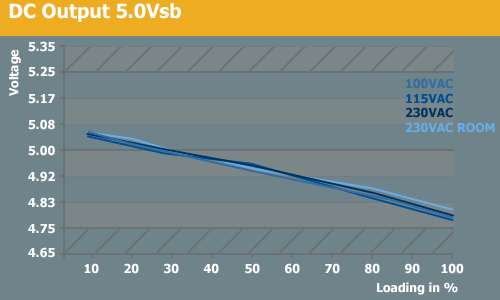
12V DC Output
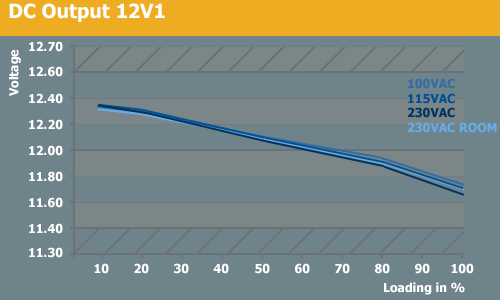
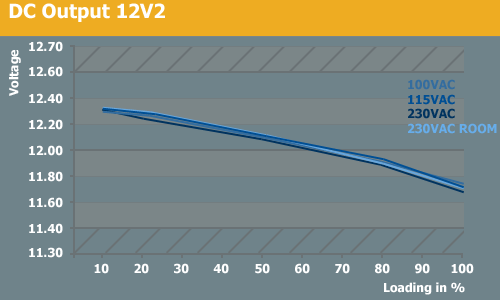
By far the most important rails on any power supply are the 12V rails. Unlike the 3.3 and 5V rails, the Silver Power Blue Lightning delivers a good, stable output on the 12V rails regardless of load. Again, the 12V outputs are very similar regardless of input voltage or temperature, and both rails are also nearly identical.
As usual we are testing with our Chroma programmable loads to fully load each rail to a specific amount. This is important to get truly accurate results and not merely approximate values. The tests are conducted in two different temperature environments. One is normal room temperature of 25-26°C, while the second environment goes from room temperature and increases steadily up to 50°C. Especially during the higher temperatures we will see how good the power supplies are and what they're really made of. Components inside will perform much worse at higher temperatures, but we expect any good quality PSU to deal with such test conditions without failing.
Note: If you would like to know more about our testing methodology, equipment, and environment, please read our PSU testing overview.
| DC Outputs | |||||
| PSU Load | 3.3V | 5V | 12V1 | 12V2 | Wattage (All Rails) |
| 10% | 1.42A | 1.78A | 1.89A | 1.89A | 61.5W |
| 20% | 2.85A | 3.56A | 3.78A | 3.78A | 122.5W |
| 50% | 7.12A | 8.90A | 9.44A | 9.44A | 301.0W |
| 80% | 11.39A | 14.24A | 15.11A | 15.11A | 472.5W |
| 100% | 14.24A | 17.79A | 18.88A | 18.88A | 578.0W |
3.3V DC Output

The 3.3V rails were stable during testing, as usual showing a constant drop under increasing load. At maximum loads, the 3.3V rail does go out of spec, regardless of temperature. However, the consistency of the rail outputs regardless of temperature and input voltage is surprising, with all four test results paralleling each other.
5.0V DC Output

Results with the 5V rail are similar to the 3.3V rail. All four test cases parallel each other, dropping steadily under increasing load. At about 90% load, the 5V rail falls out of spec. It is unlikely that most users will put anywhere near a 90% load on a 600W power supply, and provided you stay below 80% load on the 3.3V and 5V rails there shouldn't be any problems.
5Vsb Output

12V DC Output


By far the most important rails on any power supply are the 12V rails. Unlike the 3.3 and 5V rails, the Silver Power Blue Lightning delivers a good, stable output on the 12V rails regardless of load. Again, the 12V outputs are very similar regardless of input voltage or temperature, and both rails are also nearly identical.










33 Comments
View All Comments
meyergru - Tuesday, August 28, 2007 - link
...how do those two statements add up?"In fact, the efficiency is above 80% over almost the entire range which can not only save money on electrical costs but is also generally a good indicator of power supply quality. "
"This isn't an ideal result, but at the same time PFC isn't necessarily one of the most critical factors in determining power supply quality."
As far as I know, a PFC of ~0.92 means 8% more will actually be billed to me by the provider. Thus, the good efficiency of over 80% does not help at all.
13Gigatons - Tuesday, September 4, 2007 - link
PFC intended purpose is to turn a complex load into a simple one.http://en.wikipedia.org/wiki/Power_factor_correcti...">http://en.wikipedia.org/wiki/Power_factor_correcti...
mindless1 - Thursday, August 30, 2007 - link
Meeting the 80% efficiency does still help, but you are pointing out one of the interesting developments these days, how PSU manufacturers are tweaking to arrive at higher efficiency and that within the context of expectations of how the industry (reviewers et al) will review, particularly when it's a retail product. Robbing Peter to pay Paul is ideally bad, but at any given moment and price, can be subjectively more or less important depending on your needs.The important part is that this information was revealed so you can decide for youself if this unit meets those needs or if you'd rather some other compromise. No PSU is perfect in every way including price.
Christoph Katzer - Tuesday, August 28, 2007 - link
What was the relation of the both again?Your provider charges reactive power?
swtethan - Tuesday, August 28, 2007 - link
I'd like to see where the x-pro stands to see if I should upgrade or not :) got an ETA on that? All over the forums for the past 5 months that PSU has been on banners :PMissPriss - Monday, August 27, 2007 - link
Great review, though perhaps Anandtech should consider gearing a small percentage of articles to those who aren't technomaniacs. BTW - how do you pronouce "Anandtech"?JarredWalton - Monday, August 27, 2007 - link
I'll take the second part - I think there might be some less-techy articles on occasion, but the PSU stuff definitely doesn't qualify.Anyway, for those interested, it's pronounced Ahn-Ahnd-Tech. Or "On Ond Tech". So if you pronounce it with a nice southern twang and an "A as in apple" sound, Anand might make weird faces at you. That, or I need to check my hearing and make sure Anand isn't saying, "Hi guys, it's '&n - &n(d)" as opposed to "Hi guys, it's 'än - änd." (When did http://en.wikipedia.org/wiki/International_Phoneti...">phonetic symbols get so stinking complex?)
SemiCharmed - Monday, August 27, 2007 - link
I agree with MissPriss. It could be called "NotsoAnandtech"DividedweFall - Monday, August 27, 2007 - link
Hoorah for MissPriss! I don't send comments in fear of being rejected by the eleet technomanic crowd.Samus - Monday, August 27, 2007 - link
We readers at Anandtech are loyal to this place BECAUSE the reviews are for technomaniacs. They're among the most thorough reviews of hardware around.Go look at any other site's PSU reviews and you'll see what I mean.